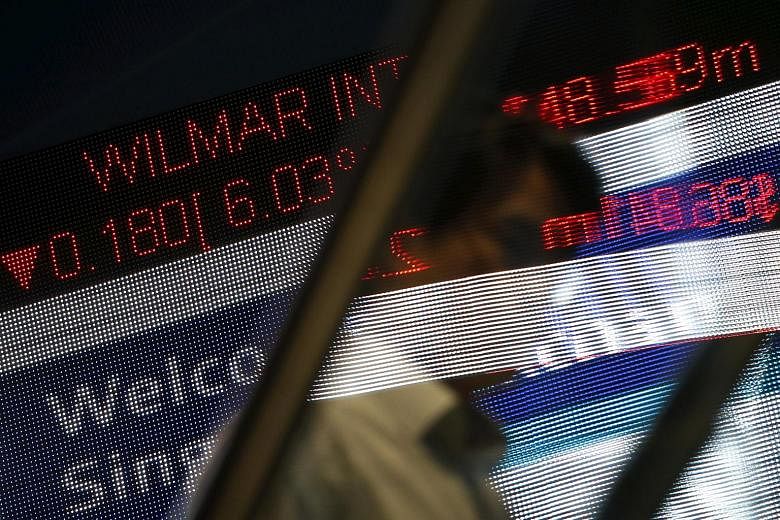SINGAPORE (BLOOMBERG) - Southeast Asia's biggest companies have increased debt sixfold since the regional financial crisis, stoking concern over default risks as investors draw parallels with the 1998 meltdown.
The region's 100 largest listed companies by assets, including Thailand's CP ALL Pcl, Petron Corp. of the Philippines and Singapore's Wilmar International Ltd., had accumulated US$392 billion (S$552.6 billion) by June 30, data compiled by Bloomberg show. That's up six times from December 1998. Debt loads as a proportion of assets are climbing back near levels from the crisis at 31.7 per cent, up from 29.5 per cent in 2010.
Slowing regional growth, China's yuan devaluation and the outlook for higher US interest rates sparked a selloff in Southeast Asia that sent the ringgit and the rupiah to their lowest levels since 1998. Default risk in Asia outside Japan posted the sharpest jump in 2015 last month, bonds lost the most in two years and shares suffered their worst slide since 2011.
"Companies still clearly have their foot on the expansion throttle, they show no sign of slowing down just yet at a time where the road is becoming more bendy," said Bertrand Jabouley, director of Asia-Pacific corporate ratings in Singapore at Standard & Poor's. "Currency depreciations are the bitter icing on the cake and they come at a time when debt-funded expansion has weakened corporate balance sheets."
S&P said foreign-currency debts grew two to three times more rapidly than local debt for Malaysian, Philippine and Indonesian companies between 2010 and 2014, based on its own sample of the top 100 companies. The borrowings made up 30 to 50 per cent of total debt there, it said.
Credit quality has been declining in the region and that's a worrisome trend, according to Kim Jinha, the head of global fixed income in Seoul at Mirae Asset Global Investments Co.
"We won't see any meaningful reversal until the global economy picks up again," Kim said. "The default rate will increase, likely at a moderate pace. Highly indebted corporates will suffer from further US dollar strength."
Total obligations at Wilmar, which grows oil palms, doubled to US$22.4 billion since 2010, while net debt rose 20 per cent. The jump was partly due to its expansion into the sugar industry, the company said by e-mail on Aug 28, adding that revenue rose 42 per cent over that time.
CP All, Petron CP All, which operates 7-11 stores in Thailand, generated US$1.3 in earnings before interest and taxes for every US$1 of interest expense, slipping from 5-to-1 coverage in 2013, Bloomberg data show. Samrej Zeepongsekul, an officer at the corporate communications division of the company, said by e-mail that the increase in liabilities was due to the debt-financed acquisition of Siam Makro in 2013. He said the funding was in local currency so the baht drop wouldn't have an impact.
Petron's debt-to-Ebitda ratio expanded to 10.6 times from 5.4 in 2010. Petron didn't immediately reply to e-mails seeking comments and a call to the number on its website went unanswered.
Southeast Asia's biggest economies are grappling with slumping demand from China as growth in gross domestic product there cools to the least since 1990. Indonesia expanded at the slowest pace since 2009, while Singapore's economy shrank the most since 2012 in the second quarter.
Half of emerging markets are in worse shape than they were in 1995, based on a combination of current-account and fiscal deficits, according to Citigroup Inc. While governments have cut foreign debt, companies have expanded theirs, the bank said in an Aug. 27 report.
While the yuan devaluation last month by the People's Bank of China caught the market by surprise, investors still have confidence in the central bank's steps and that has contained volatility, according to Leong Wai Hoong, a senior money manager in Singapore at Nikko Asset Management Co., which manages about US$162 billion.
"It is the spillover effects to other currency pairs or asset classes that people are worried about," Leong said.
The MSCI South East Asia Index of shares in the region fell 11 per cent since July 31, the biggest monthly decline since September 2011. The ringgit depreciated 7.8 per cent while the rupiah lost 3.7 per cent. The baht slid to a six-year low.
Credit-default swaps protecting Indonesian government debt have risen every month since February and reached 259.5 basis points on Aug. 24, near a two-year high, according to data provider CMA. The contract on Malaysia hit a four-year high of 202.8 on the same day. The index for all of Asia excluding Japan jumped 22 basis points in August, the sharpest increase since January 2014.
The signs of stress in the region's credit markets add to worldwide concerns, after 71 bond defaults globally this year through Aug. 27 compared with 60 in all of 2014, according to S&P. Emerging-market companies have accounted for 14, versus 15 in all of last year. PT Berau Coal Energy made a distressed exchange for US$950 million of dollar bonds in July.
"The major test for financial discipline will be in the second half 2015 and even more in 2016," said S&P's Jabouley. "Refinancing, especially with sizeable bond maturities in 2017, could be the iceberg waiting for the ship that cruises too rapidly."

